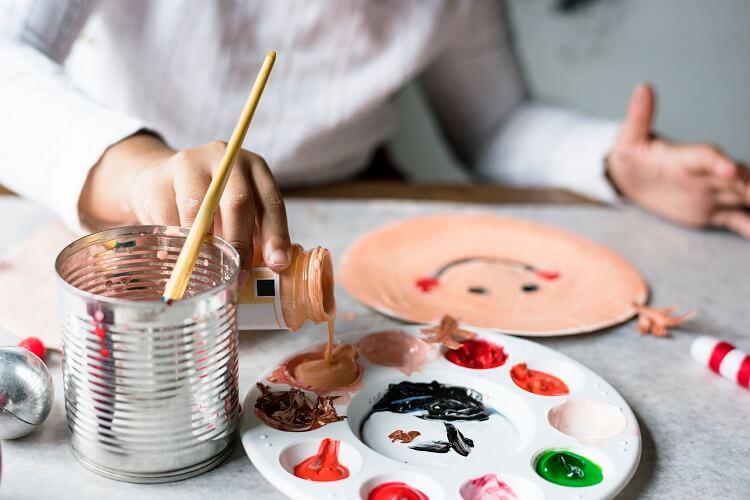Fine Motor Activities for Kids: Motor Activities for Infants


Welcome to our blog on Fine Motor Activities for Kids! In this post, we will be focusing on motor activities for infants. Fine motor skills are essential for a child’s development as they enable children to perform everyday tasks such as holding a spoon, drawing, and tying their shoelaces. Infants develop fine motor skills through exploration and play, and it’s essential to provide them with age-appropriate activities that will help strengthen their small muscles.
In this post, we will be sharing some fun and easy motor activities that you can do with your infant to help improve their fine motor skills. These activities are designed to be engaging and enjoyable for both you and your baby, so let’s dive in and explore some of the best motor activities for infants!
Kids Online Activities
In today’s digital age, children have access to a wide range of online activities that can be both entertaining and educational. However, as a parent or caregiver, it’s important to ensure that the online activities your child engages in are safe, and appropriate, and provide meaningful learning opportunities.
Here are some online activities that are both fun and educational for kids:
- Online Games: There are many online games that are designed to be educational and entertaining. Games like Math Blaster and Reading Eggs can help children improve their math and reading skills while having fun.
- Virtual Tours: Many museums, zoos, and other educational institutions offer virtual tours that allow children to explore and learn about different topics in a fun and interactive way.
- Coding: Coding is a valuable skill for children to learn, and there are many online resources available that can help them get started. Websites like Scratch and Code.org offer free coding tutorials and projects that can help children develop their coding skills.
- Online Storytelling: Websites like Storyline Online and Reading Rainbow offer free online storytelling videos that children can watch and enjoy. These videos can help improve their listening and comprehension skills.
- Online Crafts: Websites like Kids Craft Room and Activity Village offer online craft tutorials that children can follow along with. These activities can help improve their fine motor skills and encourage creativity.
When allowing children to engage in online activities, it’s important to set guidelines and limits to ensure their safety and well-being. Parents should monitor their children’s online activities, set screen time limits, and ensure that they are engaging in appropriate content.
Fine Motor Activities for Kids
Fine motor skills are essential for children’s development, as they enable them to perform everyday tasks such as holding a pencil, using scissors, and buttoning clothes. Fine motor skills involve the coordination of small muscles in the hands, fingers, and wrists, and can be improved through practice and engaging in activities that strengthen these muscles.
Here are some fun and easy fine motor activities for kids:
- Playdough: Playing with playdough is a great way to improve fine motor skills. Children can squeeze, roll, and mold the dough to develop their hand and finger strength.
- Cutting and Pasting: Cutting and pasting activities require the use of scissors and glue, which help improve hand-eye coordination and fine motor skills. Children can cut out shapes, pictures, and letters from paper and paste them onto a surface.
- Beading: Beading activities require children to use their fingers to thread beads onto a string or wire, which helps improve hand and finger strength.
- Finger Painting: Finger painting is a fun way for children to improve their fine motor skills. Children can use their fingers to create different patterns and designs, which helps improve hand-eye coordination and finger strength.
- Puzzles: Puzzles are a great way to improve fine motor skills as they require children to manipulate small pieces and fit them together. Puzzles come in different shapes and sizes, and children can start with simple puzzles and gradually move on to more challenging ones.
- Tearing Paper: Tearing paper is a simple yet effective way to improve hand and finger strength. Children can tear paper into different shapes and sizes and use them for other art activities.
These fine motor activities are not only fun for children but also help improve their hand and finger strength, coordination, and dexterity. By engaging in these activities, children can develop the skills they need to perform everyday tasks with ease.
Also Read: Earth Day Activities for Kids: Let’s Celebrate Earth Day with Kids With Fun Activities!
Motor Activities for Infants
Motor activities are essential for infants’ development, as they help improve their gross and fine motor skills, coordination, and balance. Motor activities should be age-appropriate and designed to engage and stimulate infants.
Here are some fun motor activities for infants:
- Tummy Time: Tummy time is an excellent way for infants to improve their neck and upper body strength. Place your infant on their tummy on a soft surface, and encourage them to lift their head and chest up.
- Sensory Play: Sensory play involves providing infants with different textures and materials to explore. You can create a sensory bin with materials like rice, beans, and fabric scraps for your infant to touch and explore.
- Baby Gym: A baby gym is a great way for infants to improve their gross motor skills. A baby gym has hanging toys and objects that encourage infants to reach and grab.
- Mirror Play: Infants love to look at themselves in the mirror. You can place your infant in front of a mirror and encourage them to reach out and touch their reflection.
- Rolling and Crawling: Rolling and crawling activities help infants develop their gross motor skills and coordination. Place your infant on their back and gently roll them from side to side, or place toys just out of their reach to encourage them to crawl towards them.
- Finger Play: Finger play activities involve gently moving your infant’s fingers and toes. You can sing songs like “This Little Piggy” or “Round and Round the Garden” while moving your infant’s fingers and toes.
Also Read: Online Coloring Games for Kids: Apps Which Can Help Us
These motor activities are not only fun for infants but also help improve their gross and fine motor skills, coordination, and balance. By engaging in these activities, infants can develop the skills they need to explore their environment and interact with the world around them.
Motor Activities for Toddlers
Toddlers are full of energy and enthusiasm, and motor activities are a great way to channel their energy and improve their gross and fine motor skills, coordination, and balance. Toddlers learn best through play, and motor activities that are fun and engaging will keep them entertained and help them develop new skills.
Here are some fun motor activities for toddlers:
- Obstacle Course: Set up an obstacle course in your backyard or indoor play area using items like tunnels, cones, and stepping stones. Encourage your toddler to crawl, climb, and jump over obstacles.
- Ball Games: Ball games like kicking and throwing help improve gross motor skills and coordination. You can set up a mini-soccer game or play catch with a softball.
- Water Play: Water play is a fun way to improve fine motor skills. You can fill a shallow basin with water and provide cups, funnels, and other toys for your toddler to pour and scoop with.
- Dancing: Dancing is a great way to improve gross motor skills and coordination. Put on some music and encourage your toddler to dance along.
- Playdough: Playdough is a versatile material that can be used to improve fine motor skills. Provide your toddler with playdough and tools like cutters and rollers to encourage them to create different shapes and objects.
- Balance Beam: Set up a balance beam using a plank of wood or a low, sturdy surface. Encourage your toddler to walk along the beam, first holding your hand and then independently.
These motor activities are not only fun for toddlers but also help improve their gross and fine motor skills, coordination, and balance. By engaging in these activities, toddlers can develop the skills they need to explore their environment, interact with others, and build confidence in their abilities.
Conclusion
In conclusion, Fine Motor Activities for Kids are an essential part of early childhood development that help improve fine motor skills, hand-eye coordination, and dexterity. With the increasing popularity of online school for kids, parents and educators alike are discovering new and innovative ways to incorporate fine motor activities into their virtual learning environments.
Online school provides a unique opportunity for children to engage in fine motor activities in a fun and interactive way. From virtual drawing tools to online games that promote hand-eye coordination, there are a wide variety of online resources available that can help kids develop their fine motor skills while also learning important academic concepts.
While online school has its potential drawbacks, such as the need for self-discipline and the potential for social isolation, it also offers many benefits for kids, including flexibility, personalized learning, and the opportunity to develop essential digital skills. By incorporating Fine Motor Activities into their online learning experience, parents and educators can help ensure that kids receive a well-rounded education that includes both academic and developmental components.
In conclusion, Fine Motor Activities are an important part of a child’s early development, and online school provides a unique opportunity to incorporate these activities into the virtual learning environment. By embracing this approach, parents and educators can help ensure that kids receive a high-quality education that promotes both academic and developmental growth.
Also Read: Why Online Education Is Better than Traditional? Know About the Pros and Cons of Online Platforms
Recent Posts
What are the Advantages of Online Teaching at The Real School?
In the article -"What are the Advantages of Online Teaching at The Real School?" we…
What is the Full Form of School?: Unveiling the Acronym
The term "school" carries profound significance in the realm of education, representing more than just…
What is Math Full Form?: Cracking the Code
Mathematics, often referred to as "Math," is a subject that elicits various reactions from students…
What is Full Form of Homework?: Decoding Academics
Homework, an integral part of the academic journey, often raises questions about its purpose and…
What is Full Form of Teacher?: Demystifying Education
In the intricate tapestry of education, teachers stand as the pillars shaping the intellectual and…
What is Real Education?: Discovering Its Essence and Impact
The concept of real education is evolving, transcending traditional views that equate it solely with…


